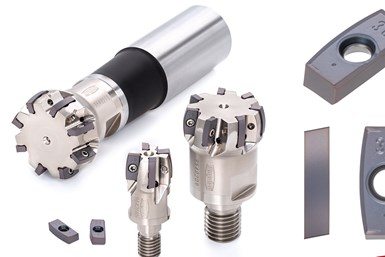Indexable Milling Cutters for Semi-Finishing of 3D Surfaces
Tungaloy’s AddForceBarrel is said to provide greater engagement area between the cutting edge and workpiece compared to conventional ballnose end mills.
Share



Hwacheon Machinery America, Inc.
Featured Content
View More





Tungaloy’s new AddForceBarrel indexable profile milling cutters feature barrel-shaped cutting edges that are designed for efficient semi-finish machining of 3D surfaces.
Based on the design of the TungMeister barrel shape milling head series, which were developed for efficient finish profiling of 3D surfaces such as complex dies and turbomachinery components in five-axis milling operations, Tungaloy’s AddForceBarrel offer an indexable insert solution.
AddForceBarrel uses inserts whose cutting edges have a large-radius arc of either 20 mm (.787″) or 30 mm (1.181″), designed for semi-finish profiling of 3D surfaces. AddForceBarrel is said to provide greater engagement area between the cutting edge and workpiece compared to conventional ballnose end mills. Greater engagement area enables larger stepovers, which improves metal removal rates for reduced number of cutter passes and cycle times.
Double-sided with two total cutting edges and ground-to-precision, AddForceBarrel inserts come in extremely small body of size 10 with cutting edges comprising a large-radius arc, which are reportedly developed with high powder-sintering and grinding technologies unique to Tungaloy. These small-size inserts enable high tooth density, enabling a 20 mm-diameter cutter to carry four inserts. The cutting edge is long enough so that the 20 mm-radius insert can be set to an optimal tilt angle at up to 21.5 degrees relative to the plane being machined and the 30 mm-radius insert at up to 16 degrees.
Furthermore, the inserts are designed to provide wide contacts with the seat when screw-clamped on the cutter, ensuring strong insert retention and part precision.
The inserts are offered in AH9130, a PVD-coated grade that provides long and predictable tool life in carbon steel, stainless steel and hardened steel.
Related Content
-
Kennametal's Expanded Tooling Portfolio Improves Performance
The company has launch eight new products that expand on and support existing platforms across multiple applications.
-
Tungaloy Expands Line of Barrel-Shaped End Mills
The new SolidMeister barrel end mills are efficient tools for complex 3D-surfacing operations used in mold making, orthopedic implants and the machining of other freeform surfaces.
-
Shoulder Milling Cuts Racing Part's Cycle Time By Over 50%
Pairing a shoulder mill with a five-axis machine has cut costs and cycle times for one of TTI Machine’s parts, enabling it to support a niche racing community.



































.png;maxWidth=300;quality=90)



